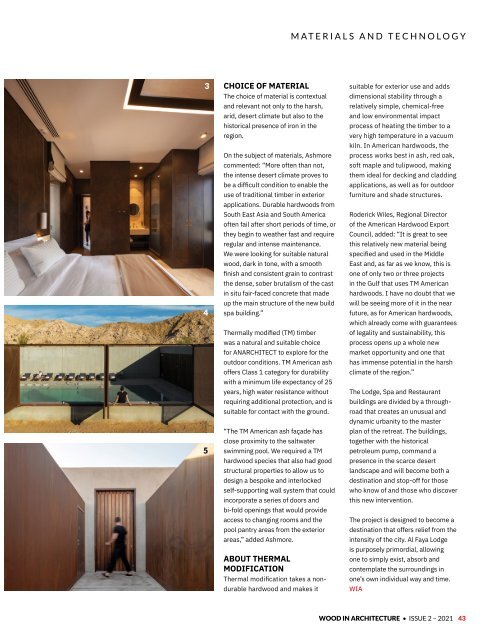Wood In Architecture Issue 2, 2021
First published in 2017, Wood in Architecture (WIA) is a bi-annual trade magazine devoted to the international timber construction sector. The newest addition to the Panels & Furniture Group of wood magazines, WIA features in-depth insights to the latest industry news, incredible projects and leading trade events. WIA is an advocate for timber as a material of choice for today’s built environment, and is the perfect source of inspiration for architects, builders, engineers and interior designers across the globe.
First published in 2017, Wood in Architecture (WIA) is a bi-annual trade magazine devoted to the international timber construction sector. The newest addition to the Panels & Furniture Group of wood magazines, WIA features in-depth insights to the latest industry news, incredible projects and leading trade events. WIA is an advocate for timber as a material of choice for today’s built environment, and is the perfect source of inspiration for architects, builders, engineers and interior designers across the globe.
Create successful ePaper yourself
Turn your PDF publications into a flip-book with our unique Google optimized e-Paper software.
MATERIALS AND TECHNOLOGY<br />
3<br />
4<br />
5<br />
CHOICE OF MATERIAL<br />
The choice of material is contextual<br />
and relevant not only to the harsh,<br />
arid, desert climate but also to the<br />
historical presence of iron in the<br />
region.<br />
On the subject of materials, Ashmore<br />
commented: “More often than not,<br />
the intense desert climate proves to<br />
be a difficult condition to enable the<br />
use of traditional timber in exterior<br />
applications. Durable hardwoods from<br />
South East Asia and South America<br />
often fail after short periods of time, or<br />
they begin to weather fast and require<br />
regular and intense maintenance.<br />
We were looking for suitable natural<br />
wood, dark in tone, with a smooth<br />
finish and consistent grain to contrast<br />
the dense, sober brutalism of the cast<br />
in situ fair-faced concrete that made<br />
up the main structure of the new build<br />
spa building.”<br />
Thermally modified (TM) timber<br />
was a natural and suitable choice<br />
for ANARCHITECT to explore for the<br />
outdoor conditions. TM American ash<br />
offers Class 1 category for durability<br />
with a minimum life expectancy of 25<br />
years, high water resistance without<br />
requiring additional protection, and is<br />
suitable for contact with the ground.<br />
“The TM American ash façade has<br />
close proximity to the saltwater<br />
swimming pool. We required a TM<br />
hardwood species that also had good<br />
structural properties to allow us to<br />
design a bespoke and interlocked<br />
self-supporting wall system that could<br />
incorporate a series of doors and<br />
bi-fold openings that would provide<br />
access to changing rooms and the<br />
pool pantry areas from the exterior<br />
areas,” added Ashmore.<br />
ABOUT THERMAL<br />
MODIFICATION<br />
Thermal modification takes a nondurable<br />
hardwood and makes it<br />
suitable for exterior use and adds<br />
dimensional stability through a<br />
relatively simple, chemical-free<br />
and low environmental impact<br />
process of heating the timber to a<br />
very high temperature in a vacuum<br />
kiln. <strong>In</strong> American hardwoods, the<br />
process works best in ash, red oak,<br />
soft maple and tulipwood, making<br />
them ideal for decking and cladding<br />
applications, as well as for outdoor<br />
furniture and shade structures.<br />
Roderick Wiles, Regional Director<br />
of the American Hardwood Export<br />
Council, added: “It is great to see<br />
this relatively new material being<br />
specified and used in the Middle<br />
East and, as far as we know, this is<br />
one of only two or three projects<br />
in the Gulf that uses TM American<br />
hardwoods. I have no doubt that we<br />
will be seeing more of it in the near<br />
future, as for American hardwoods,<br />
which already come with guarantees<br />
of legality and sustainability, this<br />
process opens up a whole new<br />
market opportunity and one that<br />
has immense potential in the harsh<br />
climate of the region.”<br />
The Lodge, Spa and Restaurant<br />
buildings are divided by a throughroad<br />
that creates an unusual and<br />
dynamic urbanity to the master<br />
plan of the retreat. The buildings,<br />
together with the historical<br />
petroleum pump, command a<br />
presence in the scarce desert<br />
landscape and will become both a<br />
destination and stop-off for those<br />
who know of and those who discover<br />
this new intervention.<br />
The project is designed to become a<br />
destination that offers relief from the<br />
intensity of the city. Al Faya Lodge<br />
is purposely primordial, allowing<br />
one to simply exist, absorb and<br />
contemplate the surroundings in<br />
one’s own individual way and time.<br />
WIA<br />
WOOD IN ARCHITECTURE • ISSUE 2 – <strong>2021</strong> 43


















